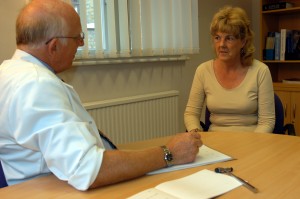How can I explain risks to my patients without frightening them?
- In order to communicate information effectively, a trusting relationship must be established first. For this reason, it is not good practice to give patients information regarding risk prior to their first consultation.
- Risk needs to be discussed in the context of a patient’s beliefs, values, and knowledge about their condition/symptoms.
- When you do come to discuss risk, put the potential risks of treatment in context; compare them with risks experienced in daily life, for example with travel. Compare risk with alternative treatments, but also compare them with the risk of doing nothing.
- You shouldn’t, however, compare risk to natural disasters or activities that they choose to do for recreation.
- Frame the risk in a positive way (x out N people will suffer no side effects) as well as in a negative way (y out of N people will suffer side effects).
- Present the risks alongside the benefits and alternative approaches available; personalise the message by drawing on your own clinical experience and the patient’s own risk factors, if any. Your own experience (e.g. long clinical experience and no adverse effects) is equally valid, perhaps more so to the patient.
- Be able to present the risks and benefits in both words, numbers, and images.
- Facts and figures relating to risk in osteopathy are presented in the risk and patient incidents section of this web resource.
How can I explain the benefits of osteopathic treatment to my patients in a way that is meaningful to them?
The information you give to patients, including benefits of treatment, must be informed by evidence as far as possible. Although there is still a paucity of good quality evidence for the benefits of osteopathic treatment, much of the available evidence is encouraging. We can learn also from studies from other disciplines where similar treatment is given to a comparable patient population using equivalent techniques. Links to new studies will be added as they are published.
In addition to randomised controlled trials and systematic reviews you can discuss with your patient other types of evidence available as well as your own personal experience of clinical practice.
You could, for example, discuss results from standardised data collection (SDC) or audit data from your own practice. NCOR, in collaboration with practising osteopaths, has developed a SDC tool for osteopaths in private practice. In 2009, a national pilot took place using the tool, and has profiled day-to-day osteopathic practice. A total of 342 practitioners (9.4% of the UK profession) participated, contributing 1630 completed patient datasets.
The SDC tools are available here so that osteopaths can use them to profile their own practice and utilise the information in discussions with patients about risk and benefit.
7. Fawkes C, Leach J, Mathias S, Moore AP. The Standardised Data Collection Project: Standardised data collection within osteopathic practice in the UK: development and first use of a tool to profile osteopathic care in 2009. Available at: https://ncor.org.uk/wp/wp-content/uploads/2013/05/standardised_data_collection_finalreport_24062010.pdf


